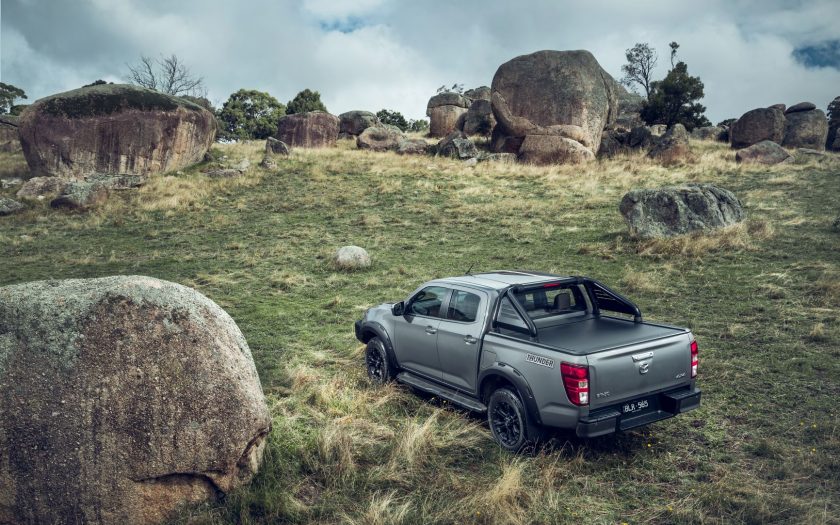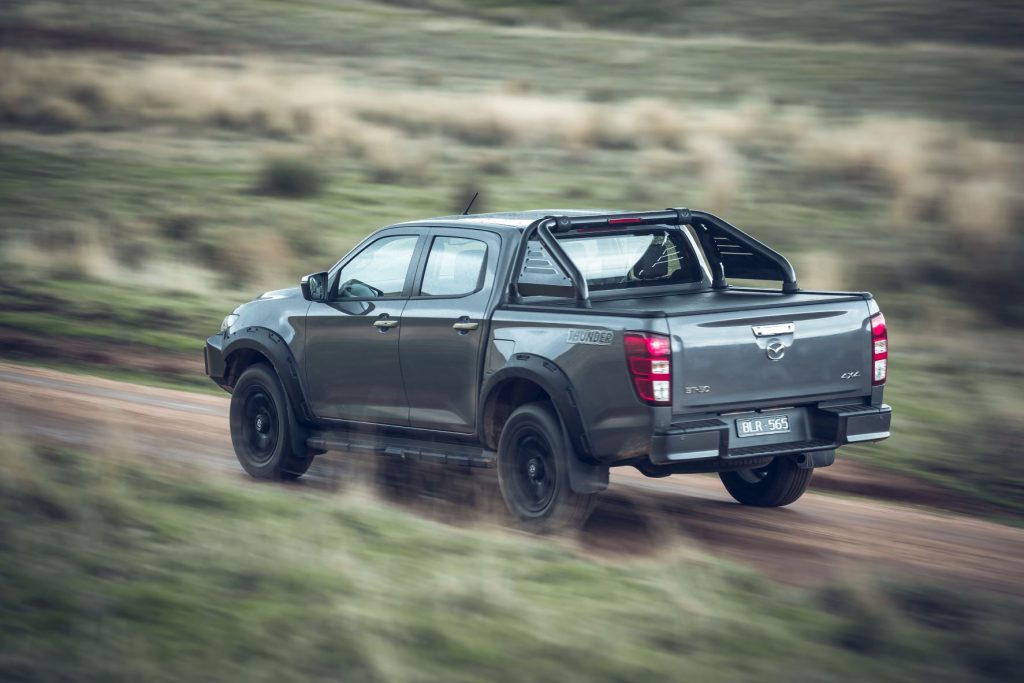Chris Riley tests the 2022 Mazda BT-50 Thunder with pricing, specs, ride and handling, safety, verdict and everything the over-50 driver needs to know.
Summary: The BT-50 is a bit of a sales disappointment for Mazda, so they’re hoping the Thunder, exclusive to the Australian market, will turn things around.
2022 Mazda BT-50 Thunder
Pricing: $68,990 (auto, plus on road costs).
Warranty: Five-years, unlimited km.
Safety: Not tested
Engine: 3.0-litre turbocharged four-cylinder diesel
Power: 140kW at 1200-2600rpm
Torque: 450Nm at 3600rpm
Transmission: six-speed automatic, all-wheel drive
Body: 5280mm (long); 1870mm (wide); 1785mm (high)
Weight: 2213kg
Towing capacity: 3500kg
Wheels: 18-inch alloy
Tyres: 265/60R18
Ground clearance: 240mm
Fording depth: 800mm
Turning circle: 12.5m
Fuel tank capacity: 76 litres
Official consumption: 8.0L/100km (diesel)
Consumption on test: 8.6L/100 (1200km)
seniordriver consumption on test: 8.8L/100km (316km)
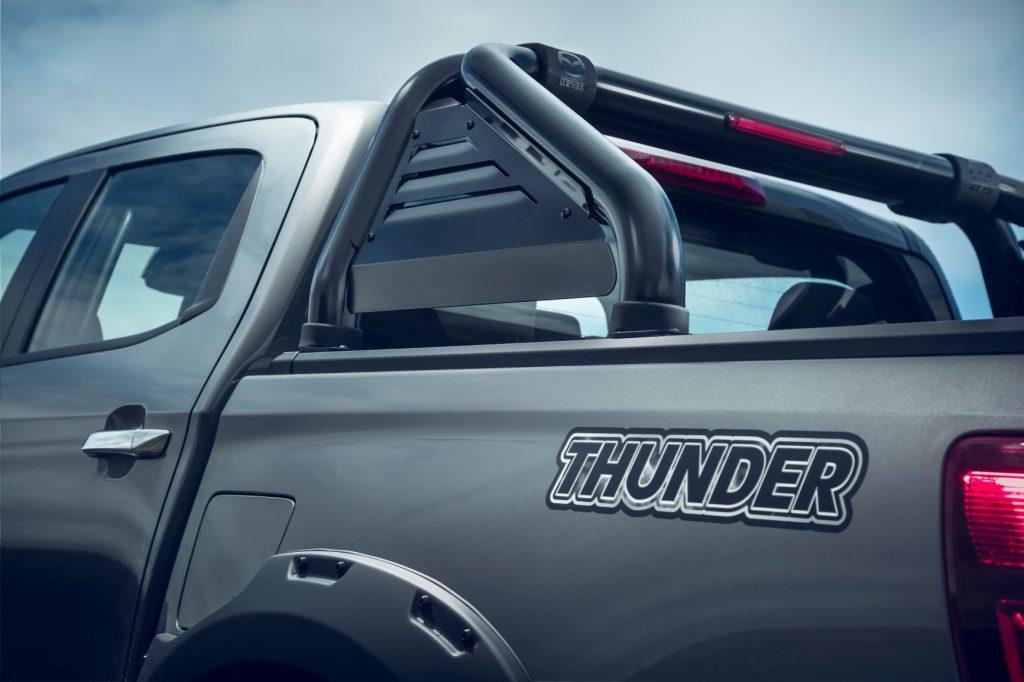
[review]
Utes have taken the Australian market by storm, with three of the top 10 selling vehicles now dual cab utilities.
Unfortunately for Mazda the BT-50 is not one of them, although in an embarrassing twist the donor Isuzu D-Max is – and therein lies the problem.
Enter, stage left, the bigger, bolder and blacker BT-50 Thunder, a special edition designed right here, with parts manufactured here and available to buy only here.
Thunder is geared with one object in mind, to attract attention – and hopefully dollars.
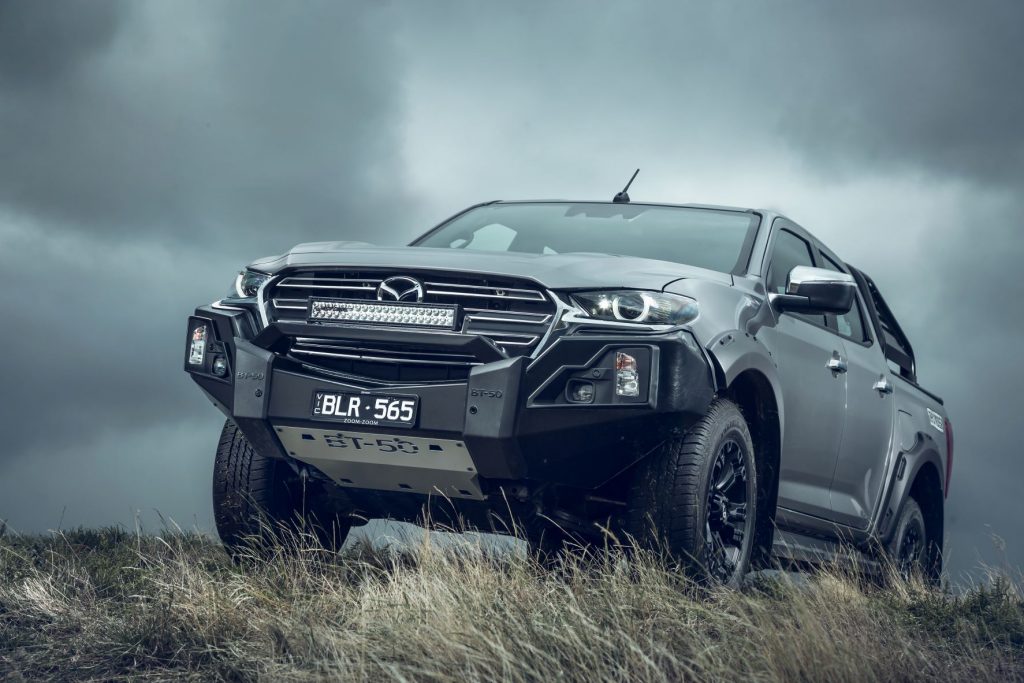
Based on the $56,990 GT model, Thunder is available with a 6-speed manual or automatic transmission, priced from $65,990 plus on-roads – an auto adds $3000.
That’s still 10 grand cheaper than Ford’s Ranger Raptor, but Raptor features a different powertrain, wider track suspension and beefier rubber.
Thunder opens its card with a prominent front-end treatment that includes a single hoop steel bull bar and a Lightforce dual-row LED light bar.
There are also black 18-inch alloys, black wide-fender flares, black side steps, and black exhaust extension, along with a premium sports bar and electric roller tonneau – also black.
All-up Mazda says the additional kit adds more than $13,000 in total value for $9000 more than GT (since then Mazda has slotted the SP model between them).
Standard kit for Thunder includes leather, dual-zone climate air, LED headlights and daytime runners, auto lights and wipers, auto dimming rear view mirror, heated front seats, eight-way power adjust driver’s seat, front and rear parking sensors, adaptive cruise control, automatic high beam and traffic sign recognition and walk-away automatic locking.
The infotainment system comprises a 9.0-inch touchscreen and eight-speaker audio system with satnav, Bluetooth streaming, AM/FM and DAB+ digital radio, Android Auto and Wireless Apple CarPlay – plus single USB and 12V outlets.
One of the speakers is mounted in the headlining, while a 6 x 9-inch woofer delivers powerful bass response and two-way dome tweeters emit clear mid- to high-range sounds.
Dash-mounted and rear door ‘balanced dome’ tweeters use a voice coil and dome-shaped diaphragm to create impressive depth.
A five-star safety package includes eight airbags, reverse camera and Autonomous Emergency Braking.
There’s also Attention Assist, Blind Spot Monitor, Emergency Lane Keeping Assist – Overtaking, Emergency Stop Signal, Automatic High Beam, Hill Descent Control, Hill Launch Assist, Lane Departure Warning, Lane Departure Prevention, Lane-keep Assist System (automatic models), Locking Rear Differential (4×4 models), Rear Cross Traffic Alert, Roll Over Protection, Secondary Collision Reduction, Speed Assist System, Traction Control System and Turn Assist.
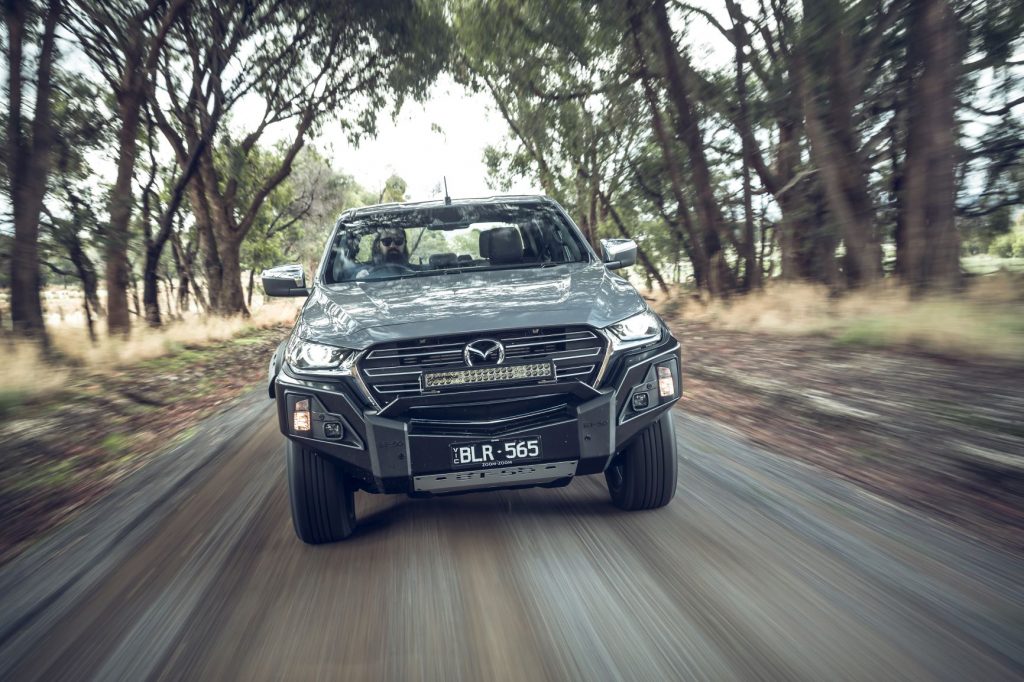 The BT-50 Thunder, in fact all BT-50s, are powered by the same turbocharged 3.0-litre, four-cylinder diesel engine, that generates 140kW of power and 450Nm of torque – the latter between 1600 and 2600rpm.
The BT-50 Thunder, in fact all BT-50s, are powered by the same turbocharged 3.0-litre, four-cylinder diesel engine, that generates 140kW of power and 450Nm of torque – the latter between 1600 and 2600rpm.
It replaces the previous 3.2-litre five-cylinder unit that was good for 147kW and 470Nm, with torque available from 1750 revs.
The new power plant features an aluminium-alloy head and cast-iron engine block, chain-driven double overhead camshafts, four valves per cylinder, drive-by-wire throttle control and a Variable Geometry System (VGS) turbocharger.
Two-wheel drive models all get a 6-speed auto, while the 4×4 version is available with a choice of 6-speed manual or 6-speed automatic.
The driver can change gears manually using the shifter in the auto, but the familiar steering wheel-mounted change paddles are absent.
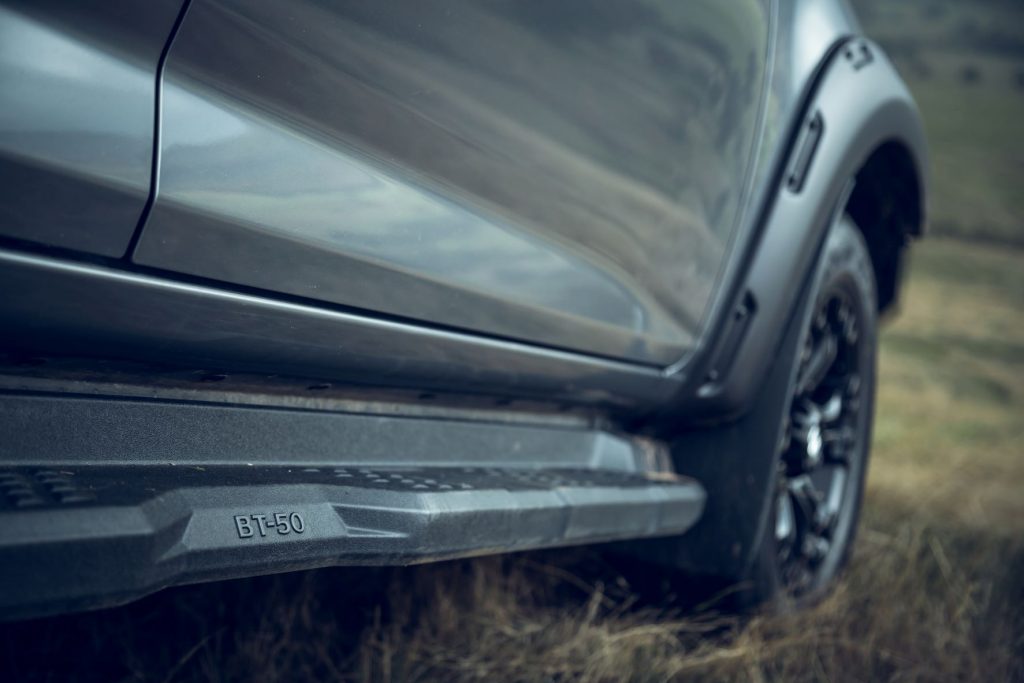
The drive experience is solid but generally slow and truck-like.
Once it’s up and running, Thunder feels relaxed and easy to drive, cruising effortlessly on the motorway while using little fuel in the process.
With a 76-litre tank, fuel consumption is rated at 8.0L/100km.
We were getting 8.6L after more than 1200km of mixed driving (not as good as the 7.8L we got out of the XTR).
The cabin is trimmed in brown leather and has dual zone climate air, with heated seats for front seat occupants and air vents for back seat passengers.
The wheel is reach and height adjustable, while the driver’s seat has eight-way power adjustment.
Unlike other Mazdas, the infotainment screen is touch sensitive, with no central control knob — but no physical volume control.
Analogue instrument gauges flank a central info screen where speed can be displayed digitally, and traffic sign recognition keeps the driver informed of the current speed limit.
Thunder is a big vehicle at almost 5.3 metres in length and weighing 2213kg, but surprisingly easy to manoeuvre, according to my wife (who likes it).
To assist in manoeuvring it comes with front and rear park sensors plus a rear-view camera.
Front suspension is independent via upper and lower wishbones with coil springs, gas-filled telescopic dampers and a stabiliser bar.
Down the back you still get old-style leaf springs, but XS models get a softer setup in keeping with their less work-oriented role.
Speed-sensitive, power-assisted rack and pinion steering is standard across the range, with 3.84 turns to lock
Switching to four-wheel drive is achieved via a rotary knob located in the lower part of the console, with high and low range available – as well as a locking rear differential in the auto.
With 240mm of ground clearance and able to ford 800mm of water, it’s got what it takes for medium off-road duties – but as always, it’s difficult to avoid denting side steps.
All grades and body types are fitted with under-body protection to guard against accidental damage off-road or in rural areas.
Thunder can carry a payload of 897kg and pull a 3500kg braked trailer.
The cargo box is 1571mm long, 1530mm wide and 490mm deep, with 1120mm between the wheel arches and four tie-down points.
A tray liner is standard and Thunder comes with a power-operated roller shutter (which decided to stop working at one stage).
There are two ISOFIX and two top tether child seat anchor points.
Servicing intervals are 12 months or 15,000km and it comes with a five-year unlimited kilometre warranty.
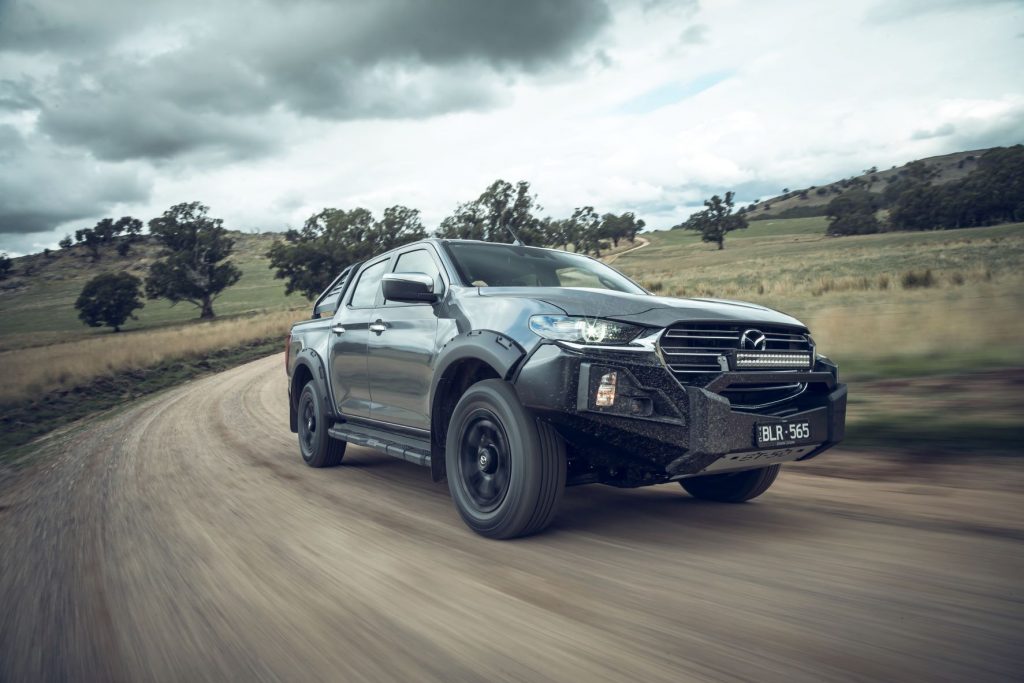
What we like
- Comfy
- Looks the goods
- Digital speedo
- Rear air outlets
- Active cruise control
- Real 4×4 credentials
- Strong on safety features
What we don’t like
- Yucky brown leather
- Touchscreen not responsive
- DAB+ access not part of radio bands
- DAB drops out a lot
- Needs wireless charge pad
- Phone repeatedly refused to reconnect
- Nanny satnav requires stop for input
What over-50s need to know
Price is the thing, and $70,000 is a big ask for a ute.
Still, it’s 10 grand less than Ford’s Raptor which continues to breed like rabbits.
Has it got what it takes to woo buyers? Mazda is pleased with the product but only time will tell …
As always, remember a ute rides higher and is more difficult to get in and out of than a sedan or SUV.
But that doesn’t stop people from buying them and it may not stop you from buying the BT-50 either.
seniordriver comments
To say we were underwhelmed with the Mazda BT-50 Thunder would be harsh, but ultimately, we came away unimpressed.
As usual, we didn’t take the big Mazda off-road, so our fuel consumption figure of 8.8L/100km is difficult to understand, especially since Chris, under varied driving conditions, achieved 8.6L/100km. That said, less than 9L/100km is impressive for a big, heavy ute, so perhaps we’re splitting hairs here.
The BT-50 in Thunder guise certainly looks the part, with lots of body kit, a substantial bull bar and that Lightforce light bar up front. And the 3500kg braked towing capacity will be a strong selling point for anyone who wants to take off with a caravan or tow a boat or horse float. But some may rue the loss of 7kW and 20Nm compared to the previous model’s 3.2-litre five-cylinder unit. We might be more willing to overlook that if the new power unit was a more civilised engine, but the simple truth is that it’s harsh, lumpy and noisy. In fact, on almost every measure, we’d take the Isuzu D-Max X-Terrain over the Mazda BT-50 Thunder every day of the week.
Chris comments that the roll-top cargo cover stopped working. That puts him one up on us because we never worked out how to get it open in the first place (fortunately, we could open the tailgate with the cover in place)!
In what is becoming a regular complaint, we found lane keep assistance very touchy and overly nervous. And we fail to understand why Mazda’s fuel consumption readout is in km/L rather than the Australian standard L/100km (although it is quite possible that the readout may have been able to be changed – we just couldn’t be bothered going through the procedure of finding out, and actually doing it).
